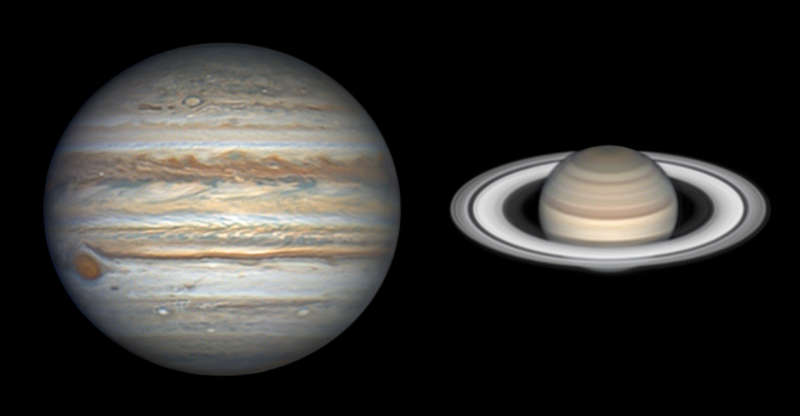
|
Credit & Copyright: Jean-Luc Dauvergne
Explanation:
As Comet NEOWISE
sweeps through northern summer skies,
Jupiter and Saturn are shining brightly,
near
opposition.
With
Jupiter
opposite the Sun on July 14 and
Saturn
on July 21, the giant planets are still near their closest to planet Earth
in 2020.
Sharing the constellation Sagittarius they are up all night,
and offer their best and brightest views at the telescope.
Both captured on July 22 from a balcony in Paris these two sharp
telescopic images
don't disappoint, showing off what the giant planets are famous for,
Saturn's bright rings and Jupiter's Great Red Spot.
These giants of the Solar System are worth following during 2020.
On December 21, skygazers can watch the once-in-20-year
great
conjunction of Jupiter and Saturn.
Comet NEOWISE images from planet Earth: July
28,
27,
26,
25,
24
|
January February March April May June July August September October November December |
| ||||||||||||||||||||||||||||||||||||||||||||||||
NASA Web Site Statements, Warnings, and Disclaimers
NASA Official: Jay Norris. Specific rights apply.
A service of: LHEA at NASA / GSFC
& Michigan Tech. U.
Based on Astronomy Picture
Of the Day
Publications with keywords: Saturn - Jupiter
Publications with words: Saturn - Jupiter
See also:
- APOD: 2025 December 14 Á Juno Flyby of Ganymede and Jupiter
- APOD: 2025 November 16 Á Crossing Saturns Ring Plane
- APOD: 2025 September 25 Á Saturn Opposite the Sun
- APOD: 2025 September 22 Á Equinox at Saturn
- APOD: 2025 May 25 Á Beneath Jupiter
- Painting with Jupiter
- APOD: 2025 April 2 Á Jupiter and Ring in Infrared from Webb
